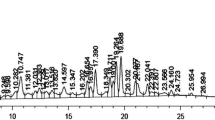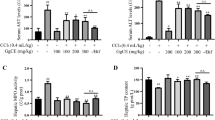Abstract
Present study aimed to evaluate the protective role of the aqueous extract of Phyllanthus niruri (P. niruri) against nimesulide-induced hepatic disoder in mice by determining levels of glutamate oxaloacetate transaminase (GOT), glutamate pyruvate transaminase (GPT) and alkaline phosphatase (ALP) in serum and also by measuring the hepatic content of the antioxidant enzymes, superoxide dismitase (SOD) and catalase (CAT); the free radical scavenger, reduced glutathione (GSH) and thiobarbituric acid reacting substances (TBARS). Aqueous extract of P. niruri was administered either orally or intraperitoneally in different doses and times as needed for the experiments. Intraperitoneal of the extract (100 mg/kg body weight for seven days) reduced nimesulide (750 mg/kg body weight for 3 days) induced increased levels of GOT (37.0±1.8 units/ml in control group vs. 91.8±2.0 units/ml in nimesulide treated group vs. 35.0±1.0 units/ml in extract treated group), GPT (30.0±2.1 units/ml in control group vs. 88.4±2.9 units/ml in nimesulide treated group vs. 34.1±1.8 units/ml in extract treated group), and ALP (7.86±0.47 KA units/ml in control group vs. 23.80±0.60 KA units/ml in nimesulide treated group vs. 7.30±0.40 KA units/ml, in extract treated group) to almost nomal. In addition, P. niruri restored the nimesulide induced alterations of hepatic SOD (550±20 units/mg total protein in control group vs. 310±13 units/mg total protein in nimesulide treated group vs. 515±10 units/mg total protein in extract treated group), CAT (99.5±2 units/mg total protein in control group vs. 25.0±1.5 units/mg total protein in nimesulide treated group vs. 81.0±0.8 units/mg total protein in extract treated group), GSH (90±3 nmoles/mg total protein in control group vs. 17±4.2 nmoles/mg total protein in nimesulide treated group vs. 81±1 nmoles/mg total protein in extract treated group) and TBARS (measured as MDA, 36.6±3.0 nmoles/g liver tissue in control group vs. 96.3±5.2 nmoles/g liver tissue in nimesulide treated group vs. 41.2±1.7 nmoles/g liver tissue in extract treated group) contents. Dose-dependent studies showed that the herb could protect liver even if the nimesulide-induced injury is severe. Intraperitoneal administration of the extract showed better protective effect than oral administration. Combining all, the data suggest that P. niruri possesses hepatoprotective activity against nimesulide-induced liver toxicity and probably acts via an antioxidant defense mechanism. To the best of our knowledge, this is the first report of the hepatoprotective action of P. niruri against nimesulide induced liver damage.
Similar content being viewed by others
References
Jaeschke H, Gores GJ, Cederbaum AL, Hinson JA, Pessayre D, Lemasters JJ. Mechanisms of hepatotoxicity. Toxicol Sci 2002; 65: 166–76.
Okuyama H, Nakamura H, Shimahara Y, Uyama N, Kwon YW, Kawada N, et al. Overexpression of thioredoxin prevents thioacetamide-induced hepatic fibrosis in mice. J Hepatol 2005; 42: 117–23.
Uzun H, Simsek G, Aydin S., Unal E, Karter Y, Yelmen NK, et al. Potential effects of L-NAME on alcohol-induced oxidative stress. World J Gastroenterol 2005; 11: 600–4.
Sultana S, Ahmed S, Sharma S, Jahangir T. Emblica officinalis reverses thioacetamide-induced oxidative stress and early promotional events of primary hepatocarcinogenesis. J Pharm Pharmacol 2004; 56: 1573–9.
Bruck R, Aeed H, Avni Y, Shirin H, Matas Z, Shahmurov M, et al. Melatonin inhibits nuclear factor kappa B activation and oxidative stress and protects against thioacetamide induced liver damage in rats. J Hepatol 2004; 40: 86–93.
Megli FM, Sabatini K. Mitochondrial phospholipid bilayer structure is ruined after liver oxidative injury in vivo. FEBS Lett 2004; 573: 68–72.
Myagmar BE, Shinno E, Ichiba T, Aniya Y. Antioxidant activity of medicinal herb Rhodococcum vitis-idaea on galactosamine-induced liver injury in rats. Phytomedicine 2004; 11: 416–23.
Bei W, Peng W, Ma Y, Xu A. NaoXinQing, an anti-stroke herbal medicine, reduces hydrogen peroxide-induced injury in NG108-15 cells. Neurosci Lett 2004; 363: 262–5.
Martin D, Rojo AI, Salinas M, Diaz R, Gallardo G, Alam J, et al. Regulation of heme oxygenase-1 expression through the phosphatidylinositol 3-kinase/Akt pathway and the Nrf2 transcription factor in response to the antioxidant phytochemical carnosol. J Biol Chem 2004; 279: 8919–29.
Gyamfi MA, Aniya Y. Antioxidant properties of Thonningianin A, isolated from the African medicinal herb, Thonningia sanguinea. Biochem Pharmacol 2002; 63: 1725–37.
Guerra MC, Speroni E, Broccoli M, Cangini M, Pasini P, Minghett A, Crespi-Perellino N, Mirasoli M, Cantelli-Forti G, Paolini M. Comparison between chinese medical herb Pueraria lobata crude extract and its main isoflavone puerarin antioxidant properties and effects on rat liver CYP-catalysed drug metabolism. Life Sci 2000; 67: 2997–3006.
Chauhan CK, Nanivadekar SA, Billimoria FR. Effect of a herbal hepatoprotective product on drug metabolism in patients of cirrhosis and hepatic enzyme function in experimental liver damage. Ind J Pharmacol 1992; 24: 107–10.
Lin TJ, Su CC, Lan CK, Jiang DD, Tsai JL, Tsai MS. Acute poisonings with Breynia officinalis—an outbreak of hepatotoxicity. J Toxicol Clin Toxicol 2003, 41: 591–4.
Naik AD, Juvekar AR. Effects of alkaloidal extract of Phyllanthus niruri on HIV replication. Indian J Med Sci 2003; 57: 387–93.
Unander DW, Webster GL, Blumberg BS. Usage and bioassays in Phyllanthus (Euphorbiaceae). IV. Clustering of antiviral uses and other effects. J Enthnopharmacol 1995; 45: 1–18.
Tona L, Ngimbi NP, Tsakala M, Mesia K, Cimanga K, Apers S, De Bruyne T, Pieters L, Totte J, Vlietinck AJ. Antimalarial activity of 20 crude extracts from nine African medicinal plants used in Kinshasa, Congo. J Ethnopharmacol 1999; 68: 193–203.
Odetola AA, Akojenu SM. Anti-diarrhoeal and gastro-intestinal potentials of the aqueous extract ofPhyllanthus amarus (Euphorbiaceae). Afr J Med Sci 2000; 29: 119–22.
Asha VV, Akhila S, Wills PJ, Subramoniam A. Further studies on the antihepatotoxic activity of Phyllanthus maderaspatensis Linn. J Ethnopharmacol 2004; 92: 67–70.
Padma P, Setty OH. Protective effect of Phyllanthus against CCl4-induced mitochondrial dysfunction. Life Sci 1999; 64: 2411–7.
Sebastian T, Setty OH. Protective effect ofPhyllanthus against ethanol-induced mitochondrial dysfunction. Alcohol 1999; 17: 29–34.
Jeena KJ, Joy KL, Kuttan R. Effect of Emblica officianlis,Phyllanthus amarus and Picrorrhiza kurroa on N-nitrosodiethylamine induced hepatocarcinogenesis. Cancer Lett 1999; 136: 11–6.
Giuliano F, Ferraz JG, Pereira R, de Nucci G, Warner TD. Cyclooxygenase selectivity of non-steroidal anti-inflammatory drugs in humans: ex vivo evaluation. Eur J Pharmacol 2001; 426: 95–103.
Bennett A. Overview of nimesulide. Rheumatology (Oxford) 1999; (38 Suppl 1): 1–3.
Davis R, Brogden RN. Nimesulide. An update of its pharmacodynamic and pharmacokinetic properties, and therapeutic efficacy. Drugs 1994; 48: 431–54.
McCormick PA, Kennedy F, Curry M, Traynor O. COX 2 inhibitor and fulminant hepatic failure. Lancet 1999; 353: 40–1.
Schattner A, Sokolovskaya N, Cohen J, Fatal hepatitis and renal failure during treatment with nimesulide. J Intern Med. 2000; 247: 153–5.
Lucena MI, Camargo R, Andrade RJ, Perez-Sanchez CJ, Sanchez De La Cuesta F. Comparison of two clinical scales for causality assessment in hepatotoxicity. Hepatology 2001: 33: 123–30.
Rodrigo L, de Francisco R, Perez-Pariente JM, Cadahia V, Tojo R, Rodriguez M, Lucena MI, Andrade RJ. Nimesulide-induced severe hemolytic anemia and acute liver failure leading to liver transplantation. Scand J Gastroenterol 2002; 37: 1341–3.
Reitman S, Frankel S. A colorimetric method for the determination of serum glutamic oxalacetic and glutamic pyruvic transaminases. Am J Clin Pathol 1957; 28: 56–63.
Kind PRN, King EJ. Estimation of plasma phosphatase by determination of hydrolysed phenol with amino-antipyrine. J Clin Pathol 1954; 7: 322–6.
Nishikimi M, Rao NA, Yagi K. The occurrence of superoxide anion in the reaction of reduced phenazine methosulfate and molecular oxygen. Biochem Biophys Res Commun 1972; 46: 849–54.
Kakkar P, Das B, Viswanathan PN. A modified spectrophotometric assay of superoxide dismutase. Indian J Biochem Biophys 1984; 21130–2.
Bonaventura J, Schroeder WA, Fang S. Human erythrocyte catalase: an improved method of isolation and a revaluation of reported properties. Arch Biochem Biophys 1972; 150: 606–17.
Ellman GL. Tissue sulphydryl group. Arch Biochem Biophys 1959; 82: 70–7.
Esterbauer H and Cheeseman KH. Determination of aldehydic lipid peroxidation products: Malonaldehyde and 4-hydroxynonenal. Methods enzymol 1990; 186: 407–21.
Bradford MM. A rapid and sensitive method for the quantitation of microgram quantities of protein utilizing the principle of protein-dye binding. Anal Biochem 1976; 72: 248–54.
Sbeit W, Krivoy N, Shiller M, Farah R, Cohen HI, Struminger L, et al. Nimesulide-induced acute hepatitis. Ann Pharmacother 2001; 35: 1049–52.
Van Steenbergen W, Peeters P, De Bondt J, Staessen D, Buscher H, Laporta T, et al. Nimesulide-induced acute hepatitis: evidence from six cases. J Hepatol 1998; 29: 135–41.
Bernareggi A. Clinical pharmacokinetics of nimesulide. Clin Pharmacokinet 1998; 35: 247–74.
Berson A, Wolf C, Berger V, Fau D, Chachaty C, Fromenty B, et al. Generation of free radicals during the reductive metabolism of the nitroaromatic compound, nilutamide. J Pharmacol Exp Ther 1991; 257: 714–9.
Ritter CL, Malejka-Giganti D. Nitroreduction of nitrated and C-9 oxidized fluorenesin vitro. Chem Res Toxicol 1998; 11: 1361–7.
Mingatto FE, dos Santos AC, Rodrigues T, Pigoso AA, Uyemura SA, Curti C. Effects of nimesulide and its reduced metabolite on mitochondria. Br J Pharmacol 2000; 131: 1154–60.
Kizaki M, Sakashita A, Karmakar A, Lin CW, Koeffler HP. Regulation of manganese superoxide dismutase and other antioxidant genes in normal and leukemic hematopoietic cells and their relationship to cytotoxicity by tumor necrosis factor. Blood 1993; 82: 1142–50.
Radi R, Turrens JF, Chang LY, Bush KM, Crapo JD, Freeman BA. Detection of catalase in rat heart mitochondria. J Biol Chem 1991; 266: 22028–34.
Halliwell B, Gutteridge JMC. Free radicals in biology and Medicine, 3rd ed. (Oxford University Press, Oxford), 1999. p. 237–48.
Author information
Authors and Affiliations
Corresponding author
Rights and permissions
About this article
Cite this article
Chatterjee, M., Sil, P.C. Protective role ofPhyllanthus niruri against nimesulide induced hepatic damage. Indian J Clin Biochem 22, 109–116 (2007). https://doi.org/10.1007/BF02912892
Issue Date:
DOI: https://doi.org/10.1007/BF02912892




